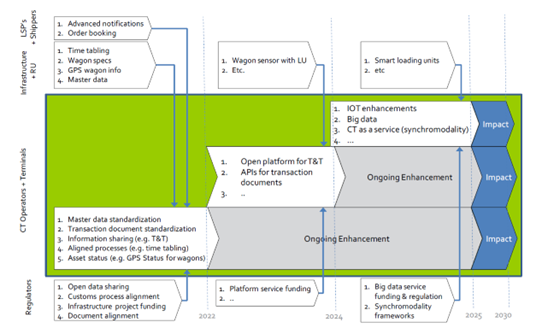Digitalisation means the use of digital technologies to change processes and to provide new revenues and value-creation through enhanced products and services. It is an important value creator for freight logistics and Combined Transport. Building on the voluntary digitalisation by market players such as UIRR, government actors in charge of enforcement should also digitalise to maximise the competitiveness gains. The European Union has undertaken several initiatives to untap this potential.
The Electronic Freight Transport Information Regulation
The EU Regulation (EU) 2020/1056 on electronic freight transport information (eFTI) entered into force in August 2020, and will become fully applicable as of August 2025. The eFTI Regulation establishes the legal framework for electronic information exchanges between the economic operators and the Member States authorities on the movement of cargo in the European Union. The information concerned is that required by the EU and national legislation to prove compliance with EU and national rules on the movement of goods by rail, road, inland waterways and air. This Regulation applies to regulatory information requirements set out in various Regulations and Directives such as the Article 3 of the Directive 92/106 on Combined Transport.
By Decision of 9 April 20151, the Commission set up an expert group on digital freight transport and logistics, called the ‘Digital Transport and Logistics Forum’ (DTLF) . The DTLF provides a platform for structural dialogue, provision of technical expertise, and cooperation and coordination between the Commission, Member States and the transport and logistic sector. Its goal is to assist the Commission in the development and implementation of the Union’s legislation, activities and programmes targeted at full-scale digital interoperability and data exchange in a shared, secured and trusted transport and logistics environment. Over time, the DTLF has been instrumental in supporting the preparation and implementation of the Regulation on electronic freight transport information – eFTI, and in providing the necessary expertise in formulating design principles and technical specifications for the federation of digital platforms aimed at facilitating data sharing between all types of stakeholders in the transport and logistics sector.
Railway Sector Digitalisation
TAF TSI (Technical Specification for Interoperability relating to Telematics Applications for Freight Services): sets the functional and technical standards for exchanging harmonised information between infrastructure managers, railway undertakings and other stakeholders such as terminal operators and CT operators.
The core TAF TSI functions are listed below:
- When (at which point in a specific process)
- What (which kind of information and content) has to be sent to
- Whom (partner or partners)
- How (which format) the data must be exchanged between the partners.
- Where (reporting point) location under contractual agreement where the information must be exchanged between the partners.
TAF TSI defines the various communication aspects to be implemented by the stakeholders:
- What do we want to communicate (Defined TAF TSI Messages)
- How we want to communicate it (TAF TSI Message structure)
- When do we want to communicate it (TAF TSI Process)
- With whom do we want to communicate (TAF TSI Process)
- Where is the location we are talking about (TAF TSI Location Reference Files)
A specific governance structure has been set up aiming at harmonising the sector views of different stakeholders and to achieve a common position for topics of strategic importance towards ERA and DG MOVE as visualised hereafter. UIRR is an official member of all related TAF TSI working groups (TAF TSI working party, Joint Sector Group, SMO, Reference Files, Implementation Group).
Combined Transport Digitalisation
Through further increased digitalisation1, Road-Rail Combined Transport will continuously optimize the integration of CT flow of goods. Digitalization uses information as a so called ‘digital twin’ of the physical flow of goods to be able to visualize the planned or current status and optimize flows towards becoming a perfect synchromodal partner for shippers. The sharing of relevant information within the supply chain should ideally start in the early planning phases of a shipment and covers the planning, booking, and execution. The areas for improvement and the envisaged benefits are multiple: (1) better service quality and reliability to the end-users with a common understanding of estimated time of arrival or consistent inter-company tracking and tracing systems, (2) improved alignment on standards and processes, (3) higher flexibility and, simultaneously and (4) higher robustness and resilience towards embracing a synchromodal transport system in 2030.
The CT sector’s vision is to transform itself from a ‘road-rail freight transport’ service provider to an ‘integrated collaborative transport’ service provider for the logistics supply chain.
The digital transformation path follows a logical sequence shared by similar initiatives5. The proposed model for the roadmap follows exactly this path applied to the CT sector and the emerging Internet of Services in a phased approach which allows enough time to learn, adapt and improve. UIRR proposes to roll out the entire CT digital transformation in three distinctive phases (see annexes for full roadmap): (1) Phase 1 (2020 to 2022) focuses on lay the groundworks for the future digital transformation, (2) Phase 2 (2022 – 2024) will define the implementation of services to improve collaboration within the combined transport sector, (3) Phase 3 (2024 – 2025) will focus on platform or data hub-based supply chain spanning open data exchange and the adoption of inter-organisational service platforms where beneficial. From 2025 to 2030, the full impacts and envisioned benefits of the changes will be visible.

Digital transformation: key achievements
The following recognised achievements have largely demonstrated the key beneficial role of a digitalised CT environment:
- Tracking & tracing applications such as the CESAR platform with more than 1,000 regular customers using this unique portal
- Standardised data exchange format such as the EDIGES message which is used by a large majority of CT stakeholders in Europe for all intermodal processes (road first and last mile, terminal operations, railway journey). Compliance reports with TAF TSI messaging are available
- Development of reference files for the sector such as the UIRR codes and the rail facilities portal as a support for the daily exchange of operational data
- Development of collaborative platforms such as the KV4.0 data hub (DXI company) which facilitates the data exchange among all intermodal stakeholders including the intermodal customers such as LSPs and freight forwarders.
- Improved real-time information through digitalisation of assets and use of IoT devices (terminal automation, OCR gates and wagon GPS data , facilitation of loading ILUs on wagons, geofencing of terminals)
- Integration of artificial intelligence features in all processes (e.g. inspection of intermodal loading units at terminals)


Mateusz Nowak
Digital Project Officer


